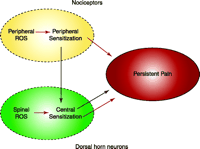The Role of Reactive Oxygen Species (ROS) in Persistent Pain
Pain is an important medical problem and has been the subject of intense study in recent years; however, we still do not understand many of the details of pain generation and analgesic mechanisms, particularly for persistent pain. This lack of sufficient understanding is a major stumbling block in the development of much better analgesic drugs.
We now know that the mechanisms of chronic or persistent pain (such as pain associated with inflammation or nerve injury) are fundamentally different from those of acute pain (sometimes called nociceptive pain or physiological pain) (1–3). In acute pain, noxious stimuli are detected by nociceptors and the information is transmitted to the brain. The situation in persistent pain, however, involves the maintenance of peripheral and/or central sensitization (Figure 1⇓). Peripheral sensitization is manifested by nociceptors such that they not only respond more vigorously to a suprathreshold stimulus but also the threshold needed for response is lowered. A common cause of peripheral sensitization is tissue inflammation. Central sensitization refers to a similar phenomenon occurring in pain-transmission neurons in the central nervous system (CNS), often in the dorsal horn of the spinal cord (1, 4, 5). Peripheral sensitization may lead to central sensitization, but central sensitization can be maintained with or without peripheral sensitization. N-methyl-d-aspartate (NMDA) receptors are thought to mediate central sensitization, and several different types of second messengers are involved in the cascade of changes that occur in the spinal cord (1–3, 5, 6).
Reactive oxygen species (ROS) have been implicated in many degenerative neurological conditions, such as Alzheimer’s disease, Parkinson’s disease, amyotrophic lateral sclerosis, and other brain dysfunctions ranging from brain injury to aging (7–13). In addition, oxidative stress is an important determinant of degenerative and painful pathological conditions in peripheral nerve fibers (14). Most of these studies, however, emphasize oxidative stress–induced cell death or degeneration. In contrast, I emphasize here the possibility that neurons that are less severely stressed survive but become dysfunctional and produce pain.
Recently, Wang et al. reported that superoxide (SO), a type of ROS, mediates pain that accompanies inflammation (15). Their experimental results indicate that an application of a synthetic compound (M40403) that mimics the enzymatic function of superoxide dismutase (SOD), which breaks down SO, prevents development of inflammation and hyperalgesia after injection of an inflammatory agent into the rat paw. Furthermore, the SOD mimetic given after induction of inflammation also reduces developed hyperalgesia. These results suggest that SO participates in the nociceptive signaling cascade and in nociceptor sensitization. The authors propose, with some supporting data, that SOD is nitrated in inflammatory conditions and loses its function. Consequently, SO accumulates and high concentrations of SO combine with nitric oxide (NO) to form peroxynitrite. Peroxynitrite inhibits the catalytic function of SOD by nitrating the enzyme. The analgesic effect produced by M40403 treatment is not blocked by naloxone, indicating that opioids are not involved in mediating the analgesia. The results are encouraging for the development of non-steroidal and non-opioid analgesics.
The essential part of this paper has been published elsewhere by the same authors at an earlier time (16). Therefore, although not a confirmation by independent investigators, the data published here confirm their earlier results; however, a few aspects of this paper are less than completely satisfactory. First, several important points are made with no quantitative data. For example, histological evidence of inflammation, immunohistochemical study for nitrotyrosine, and immunoprecipitation for manganese superoxide dismutase (MnSOD) are presented as single data points. Second, histological examination of the spinal cord for immunological staining should have been done in the dorsal horn, not on motor nuclei, to be more relevant. Nevertheless, this study provides experimental evidence supporting the strong analgesic action of an SOD mimetic on inflammatory pain.
Although SO is an important ROS, there are other reactive oxygen–containing species that may play an important role in pain as well. In addition, there may be painful conditions other than inflammatory pain in which ROS participates. One particular form of ROS, nitric oxide (NO), has been extensively studied in pain mechanisms. For example, inhibitors of nitric oxide synthase (NOS), the enzyme that produces NO, reduce both the increased concentrations of NO and some of the pain-related behaviors that follow inflammation or neuropathic lesions (17–20). Although NO is an ROS, its action as a free radical is only one of a number of possible mechanisms involving NO in neuropathic or inflammatory pain, and consequently, NO action as an ROS has not been particularly emphasized. However, Tal (21) systemically injected the antioxidant 4-hydroxy-2,2,6,6-tetramethylpiperidine-1-oxyl (TEMPOL) into rats and observed a significant reduction of heatinduced hyperalgesia in rats with chronic constriction injury (CCI), a model of neuropathic pain (22). TEMPOL acts as a catalyst and mimics the activity of SOD (21); hence, the effect mediated by TEMPOL could be similar to that observed with M40403. In addition, Khalil et al. (23) showed that systemic administration of tirilazad, an antioxidant, significantly alleviated thermal hyperalgesia in CCI rats by improving peripheral microvascular blood flow in the area innervated by the injured nerve. Although some details are lacking, these studies support the possible importance of ROS in neuropathic pain. Furthermore, recent results from our laboratory also support a role for ROS in neuropathic pain (24). In the rat spinal nerve ligation model of neuropathic pain (25), thresholds to mechanical stimuli return toward normal in a dosedependent fashion following multiple systemic doses of phenyl N-tert-butylnitrone (PBN), a powerful free radical scavenger. Neither development of tolerance nor loss of potency occurs with repeated injections of PBN, and PBN injection is equally effective if given before (preemptive) or after the neuropathic lesion. The site of action of PBN is, for the most part, spinal rather then peripheral. The results suggest that ROS scavengers can be developed as a powerful analgesic drug for neuropathic pain, which is clinically difficult to manage.
A study with a new analgesic compound can proceed in two different directions: 1) practical drug development, or 2) investigative studies for underlying mechanisms. Naturally, there are attempts to develop new analgesic to remove ROS, including the SOD-mimetic compound M40403. Furthermore, detailed and systematic studies on underlying mechanisms are important not only to provide justification for the development of a drug, but also that better drugs can be developed.
During the last several years, data has accumulated that suggest that ROS plays an important role in a variety of types of persistent pain. There are several important questions that need to be studied as to how ROS are involved in pain mechanisms. First, what ROS are important for pain production? The paper by Wang et al. (15) emphasizes SO, NO, and peroxynitrite. SO radicals are among the first compounds created in ROS production, and peroxynitrite is a stable—and therefore quite destructive—compound. Another potentially important ROS is the hydroxyl radical because it is the most destructive ROS; however, it is not very stable. Nevertheless, it is important to find out exactly which ROS is the most important player in each type of pain because such knowledge will provide us with the means to effectively control the important ROS player.
The next important question regards the source of ROS that play important roles in each type of pain. It is important to know whether the important site of action is in the periphery, the spinal cord, or the brain. It is also important to know the cellular localization (neurons vs supporting cells; peripheral tissue or glial cells in the CNS; cytoplasm vs mitochondria). Lastly, one of the most important questions to investigate would be to identify how ROS are involved in pain. The paper by Wang et al. (15) suggests that SO promotes cytokine production in the periphery and induces central sensitization. Much work is left to clarify the important processes involved in each type of pain as well as the detailed factors triggering these processes.
In summary, recent findings point out that ROS are an important factor in persistent pain. The paper by Wang et al. (15) supports this contention. There are a few other examples that illustrate the importance of ROS and many more extensive studies are expected to follow. In the near future, the effort expended on the study of ROS in mechanisms of pain generation should be fruitful in terms of both advancement of scientific knowledge and drug development.
Hypothetical reactive oxygen species (ROS) involvement in the production of persistent pain. In peripheral tissue, ROS are produced in many pathophysiological conditions, including inflammation. ROS will sensitize nociceptors so that they not only respond more vigorously to noxious stimuli but also start to respond to normally subthreshold stimuli. This peripheral sensitization not only induces pain directly (red arrows), but also induces central sensitization in the spinal cord, which indirectly (black arrows) contributes to pain as well. In the spinal cord, ROS are produced in many pathophysiological conditions, such as having persistent abnormal afferent inputs. ROS produced in the spinal cord can lead to central sensitization (red arrows), which in turn produces pain. Thus, central sensitization can lead to pain with or without peripheral sensitization.
- © American Society for Pharmacology and Experimental Theraputics 2004
References

Jin Mo Chung, PhD, is a Professor in the Department of Neuroscience and Cell Biology at the University of Texas Medical Branch, Galveston, Texas. E-mail jmchung{at}utmb.edu; fax 409-772-4687.




